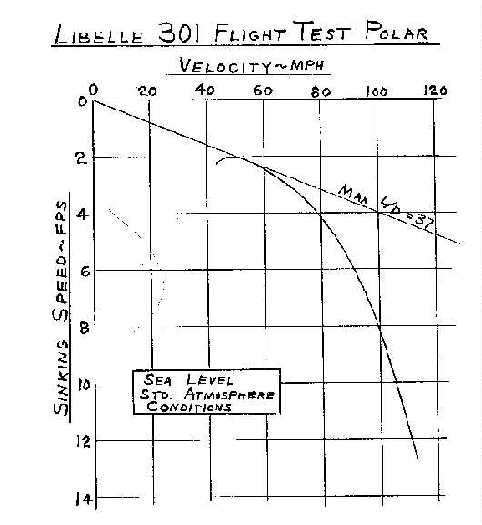
I am happy to be here. I have never been to this honored symposium before. We have heard about it and read the book and noted what everybody has said, and now I am certainly glad to be here myself.
I would like to talk to you about my competitive philosophy, and mine is quite a bit different from many persons. Maybe you will find it interesting, maybe you'll find it unforgivable, I don't know which.
When I go to a contest, and I like contests, for some reason it stimulates me and I enjoy a competitive atmosphere. I have a different philosophy, maybe because I grew up in these early contests. The points were given on a different basis. You got one point per mile and that's all you got. In the last fifteen years it has been mostly speed with one distance day and not more than two distance days in a normal contest. But I have my philosophy which has carried me through fairly well. I won't say that it is the best, but I will tell you how I do it and why I do it and we can criticize from there.
First of all, I try to choose a sailplane that is suitable to where I am going. And I have made some mistakes. I took the Tiny Mite to Elmira once and that was a dreadful mistake. Like George says, you have got to have some weak days in the contest. It is not going to be like the Chamber of Commerce says, and every day is not going to be a good day. If you don't have a sailplane that will stay up when the going gets tough, you are going to be pretty lucky to win because there are going to be too many tough days. It is almost never that you can go through the whole contest without having some rough spots. So I try to choose a ship that will stay up when conditions aren't very good, but it doesn't mean that I will take a Skylark to Marfa. I'll take a Skylark to McCook. I took a Skylark to Elmira, and I'll take a Skylark to Kansas, but I wouldn't take it to Marfa because there the wing loading is obviously too light, and the heavier wing loading ships obviously have too much advantage. When I choose my sailplane, I will also look at my competition. And as you all know, the competition is getting tougher and tougher every year. But, who are they going to be, what are they going to be flying. What is their philosophy. How can I beat them. Also, what are the rules. The rules are changing. Today we count every day as a contest day, and your philosophy has to be a bit different than it was ten or fifteen years ago when you threw out the worst speed task and you threw out the worst distance day and you counted your four out of five best days because then you had to fly a little more conservatively to maximize your probability of staying up. Maybe I am taking an engineer's approach to this, but that's my training and you'll have to bear with me.
And then again, we must consider the weather. Try to figure out what the weather really is going to be, especially in the McCook area. None of us flew in the Kansas or Nebraska area, and we had been pretty badly burned in Wichita a few years before when we found quite a few days where we couldn't get more than 2,000 feet high, and this big 8,000 foot cloud base that they told you about only happened once a year. In that particular contest, the fellow that almost won it, except for the rules, was Bill Coverdale in a K8 because Bill could stay up when the rest of us couldn't. I think in that year you had to have three people go 35 miles to make it a contest day, and Bill went around the course himself several times, but nobody else could make it and so it would be a no contest day.
I think in contest flying you have to decide what is going to be the convective height, that is, how high are the thermals going to go on an average and how far are they going to be separated. Fortunately, there is a relation. On days where thermals don't go very high, they are closer together, and it's sort of a geometric thing, but it does make you choose your philosophy a bit different. At Marfa the speed merchants do pretty good, but you get those same guys up at Mc Cook or Elmira and the rest of it and, man, the ground gets them at least once and that takes care of the championship for them. They win the days, but they don't win the contest. I think to win the contests you have got to stay up and get around the course. My whole philosophy has been "get high and stay high" -- that's in thermals, of course. Sometimes this works pretty well, but it is getting harder to win contests just by that philosophy alone. Still, it is most important to stay up and get around the course. If you are going to count every day and if your philosophy is to win the contest, not win the day -- it is great if you can win the day, but you are going to maximize your probability of having one bad day or so in the contest if you fly at your McCready ring speed all the time. I would prefer, if I had my druthers, for everybody to set their McCready indicator to a good optimistic value and just fly it there all during the contest. I'd never win a day, but I'd be pretty sure of winning the contest if I flew at 90% of that best average. I'll show you in some figures what I mean.
I think the competitive philosophy is also a function of how many competitors you have in the contest and how good they are. This makes a difference. I have flown a number of contest where you could count the good competitors on one hand and that's the only bunch you had to watch -- 5 people. But now there are more and they are getting out there faster and your type of flying is affected quite significantly by the people who go out on course. These people are marking the course. Especially at Bryan you didn't find very many thermals of your own because there were so many people -- there were 65 gliders entered and so many people out on course. You could fly a little faster then between thermals and be sure of finding one because there were six sailplanes over there and one sailplane would mark the course for you. But if you are by yourself, the probability of staying up isn't nearly as good. This is some of the philosophy that George and Jim mentioned of letting most of the competition get out on course ahead of you. It is a good idea because they could maximize your probability of staying up and you could fly more nearly at your maximum average cruise speed or your optimum speed. So I think you have to balance the penalties that you incur in these contests for flying at less than the McCready speed.
McCready's speed is again, I think, overrated. I have never used a McCready ring indicator except the last two years and I didn't win there either. The technique I use is a little different. I have a McCready ring indicator in my cockpit because John Ryan insisted that I have one, and it is not a bad idea to put it in, but use it carefully.
You have to balance the penalty that you incur from not flying at the optimum or maximum average versus the penalties that you receive in a particular contest for being forced to work weak lift occasionally. If you get down below 1,200 or 1,000 feet you are going to have to take anything you can get. You take extra time to get out of that hole and you have to average that versus how long that penalty is going to be and, also, the probability of having to land. Now if you don't complete a speed task, you seldom get more than 400 points, and often only 200, so that means that if you flew at 90 percent of the optimum speed and you did that quite consistently and your competitor flew at l00 percent but landed one day in six, that's about the breakeven point, so you have to balance these things. Also if you land out you are more likely to damage your sailplane. You don't damage them on your own field. You have to weigh that in too. I think the philosophy has to be toward winning the contest and balancing the total up that way. It is the way I do it and I'll show you some of the engineering reasons of why and what speed I like to fly and what I think the penalties are versus the probabilities of staying up.

Figure 1 is an example polar. It is a Libelle 301 polar because a lot of you flying these ships. It's very representative of a modern machine and it so happens that my HP-13 polar follows right on top of it. Anyway, this is a typical flight polar. This is what you are flying in smooth air. The velocity is the horizontal scale and how fast you sink is the vertical scale. You can see that the best L/D occurs a little over 50 miles an hour or roughly 53 miles an hour calibrated air speed, about 37:1. You can see the effect of the laminar flow drag bucket on the L/D curve. You don't pay much penalty on glide ratio until you pass roughly 70 miles an hour. At about 80 miles per hour the curve is coming down pretty rapidly. You are getting out of the laminar bucket, and you can see that anybody who tells you he is flying 120 miles per hours is kidding you or not winning, one or the other. So this is what we have got to fly and we have got to formulate our tactics on this. Let's take a non-Marfa type glide profile. I have taken the same Libelle. Let's say that it is at Bryan or McCook and 4,000 feet above the ground. Don't kid yourself, that's not bad. A lot of days we didn't get that high above the ground at Bryan, and then you can glide at these different speeds. I have said that the next thermal is going to be about 8 miles away and so let us study Figure 2.
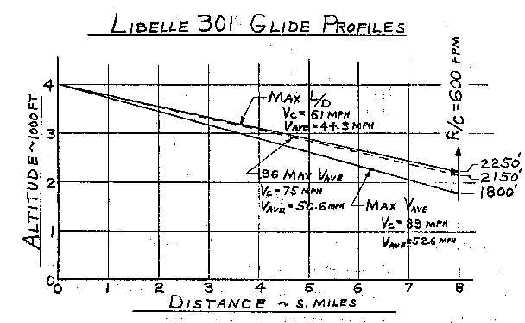
How much altitude are we going to lose when we get to the next thermal and how high are we going to be above the ground? I have shown the V-max curve (the top one). And in this you see that the cruising speed is 61 miles an hour and the thermal strength for the day is pretty good. It is 600 feet per minute. For those people who have knots indicators, that's 6 knots. You get to the thermal at 2250 feet of altitude. The cruising speed is 61 versus the 53 that I told you before because we (at Mississippi State) decided that when there is air going up, there has to be some air coming down too. So when you are going from thermal to thermal, you are going to have some down air and you are going to have to figure this in. This is a fact of life, you know, Newton figured that out. So I usually say that the rising air velocity divided by about 5 will be about my average descending air velocity between thermals. This is rather idealized and I agree that with McCready's ring indicator if you hit a down draft or an up draft, it takes it into account quite elegantly. I do this. If I hit a little more than normal sink, I'll slow down, and if it is faster than normal, then I'll speed up. But anyway our best glide ratio under these conditions with a down draft will be more like 61 miles an hour instead of 53. Then our average speed which includes the time to glide to the thermal plus the time to climb back up to the same altitude at 4,000 feet again will give us an average of 44.3 miles an hour. But now if I consider the speed I usually fly (it is somewhere between 90-97 percent of my best average speed) I cruise at 75 miles an hour under that condition -- most likely I'll average about 50.6 miles per hour. I'll arrive at the thermal only a hundred feet lower than I would if I cruise at best L/D. Notice the dashed line in Figure 2. If you flew the McCready speed ring and had the average down that I assumed there, you would fly faster speed at 89 miles an hour. You are down to the bottom curve. You would be, roughly, 350 feet lower altitude or down to 1,800 feet. Okay, you can get back up but the problem is that you can't do that all day, every day. You miss one and you have lost over 2,000 feet getting that one, and if you go to the next thermal 8 miles away, if it exists, you are not going to get there. You may have a tough time on those others also. But, again, you increase your probability of staying up.
Now this is just a difference in philosophy and, again, if you want to maximize your probability of staying up and completing the course. You have got to do this if you are going to have a chance of winning the contest.
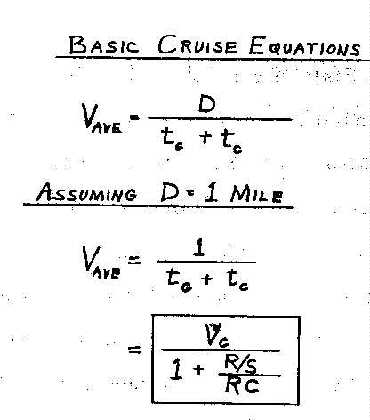
I won't try to bore you with equations, but Figure 3 is in most of the literature, including the Soaring Handbook: the average velocity is the number of miles divided by the time it takes to glide that 8 miles plus the time it takes to climb back up to 4,000 feet from whatever altitude you started. You can pretty easily run through it with your slide rule on those cold evenings and plot it if you know your basic polar. To simplify the equation I generally say that the distance is one mile, because then I have to take my average velocity and divide it by time to glide plus time to climb and that simplifies the derivation used in the Soaring Handbook. A very simple equation: your cruise velocity divided by one plus the rate of sink, that is R/S. That is the sink at the rate at which you are going to be flying (that you choose to fly), so you are going to go in with a range of arbitrary V cruise values of 70, 80, 90 miles an hour, etc. I generally plot these. You put the rate of sink in the numerator of the lower equation (Figure 3 ) and then divide that by your rate of climb in the thermal, and this comes out to be what you are going to average (assuming that you get the rate of climb that you assumed). I make these versus speed and versus rate of climb and Figure 4 is a plot showing how they look.
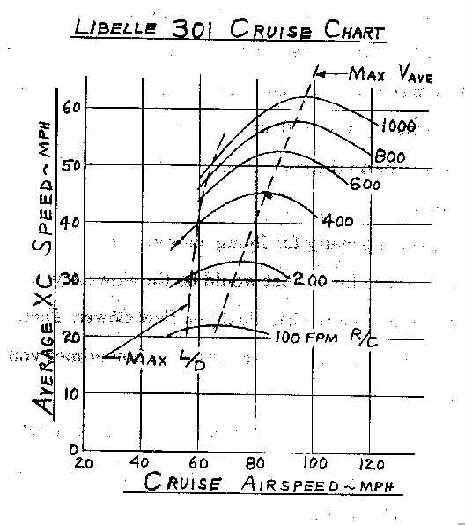
This is what I carry in my cockpit and have for years. The calculations are those funny curved solid lines that have maximum points. The average cruise speed is on the left scale. That is, average cross country cruise speed, which takes into account the climb plus the cruise. The cruise calibrated air speed is on the bottom scale so you can just go through and plug in those equations on your polar. Now the trick is that you have to have that polar, and if you didn't come to yesterday's lecture, then you are going to have to figure out how to get that polar. You can't very well use the manufacturers curves because they have always been a little notorious on their optimism. You have got to have a realistic polar to work from or you are going to kid yourself or convince yourself that you should fly 100 miles an hour between thermals. This plot (Figure 4) shows that you are going to be in bad shape unless the lift is well over 1,000 feet per minute or 10 knots between thermals. It shows that you get an optimum point, and the curves are fairly flat, at least at below 600 feet per minute rates of climb. The maximum average value is the best you could ever do, and you are just foolish to ever fly faster than that speed except on the final glide to the airport. I always try to be on the fast side of that so that I'll have that extra altitude to get to the airport.
You can also see the penalty for flying slower, and I have shown the max L/D line on the left (the dashed line). That would be the slowest you would ever want to fly because you would lose more altitude if you flew slower. There is no point in that unless you are waiting for the clouds to clear away. Sometimes you have to play that game too.
I have seen the Poles do it quite effectively. They would circle and wait until the thermals formed again and then go on. I think we might have done a little of that at Bryan. Anyway you can see that the penalty isn't very large if you fly at maybe 10 miles an hour slower than the McCready speed. I usually operate in a 90-95 percent of the average maximum cruise region, and 90 I'll be flying roughly 60-80 miles an hour and seldom faster. But again, I don't win very many days.
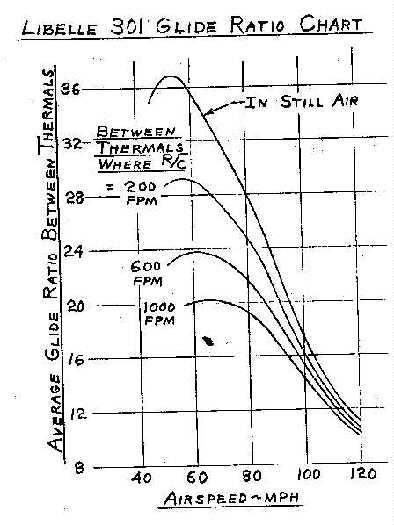
Figure 5 is the other chart that I carry in my ship. You derive it at the same time you derive the average cruise chart. I stick one on the side of the cockpit usually, and one beside it or on the other side. What is my average glide ratio going to be versus miles per hour air speed assuming that the top curve that gets up to 37 is in still air? The only way we get that top curve is to tow up to 10,000 feet at 6 o'clock in the morning. You don't get much of that in a contest. Sometimes you can approach the still air curve if you are at the end of a very long day and you have dead smooth air. Then you can rely on something like this. I generally put this Figure 5 in the cockpit to help judge the glide, but if I get some thermals, I say, "All right, if there are 200 feet per minute thermals, my max glide is only going to be about 29."
I think some people make a mistake here and say, "Well, the manufacturer is wrong or something." But he is just not looking at the air correctly, that is the down drafts and the up drafts. You have got to add these in your calculations. So on the average -- say you have got a 600 foot per minute day, which is a pretty good summer day, you are going to get about 24:1 L/D max and it is going to occur at about 61 miles an hour as I showed you in the other Figure. These are average and when you get up drafts, it is a lot better than indicated and when you get in a sink hole, it is worse than indicated.
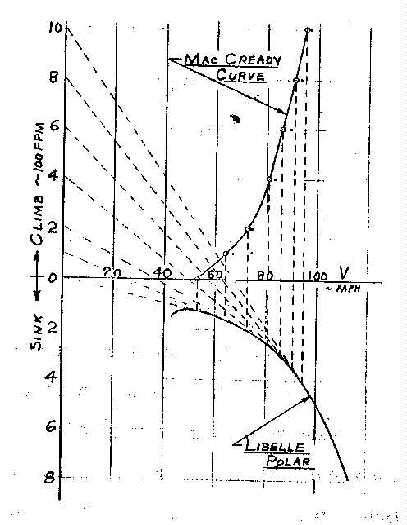
Just to show that I do know how to construct a McCready curve, I have plotted one in Figure 6 and you can see how they compare. I have got the same polar here. You must get the derivation of the McCready curve in some of the reference books. It is not very well explained in most of them, but you can derive it from Helmhoser's new book which is a rather broken German translation. Or you can look up the old McCready articles from 1954 or 1956 in Soaring and get the derivations. Essentially you take tangents to your sink polar, but you have got to have an accurate polar. You draw the tangents from the expected climb rates on the left in the Figure. Notice the dotted lines. Then read up and you get what they call the McCready curve up on top. That is really just the same things we had derived before except that this is a bit more flexible. It will take into account flying in up drafts and down drafts and not just in the average sink I assumed. The speeds come out very close to those that I calculated in my curves. In Figure 6 you can see the little black dots just to the right of the McCready curve at each of those data points. These are the points from my other calculations. They are a little faster (3-4 miles faster) than the McCready curve because they were derived assuming there is an average down draft between the thermals of 20 percent of the average up draft. This puts my optimum cruise curve a little faster than McCready's speed ring.
Anyway you see that you can get the same sort of thing, but the danger, as I see it, in flying a McCready curve, is that you don't get a very good picture of the penalties for flying at other speeds. All it does is give you a number. I would be delighted if all my competition only knew that one number and flew it until they either won or hit the ground. I think my odds are better by flying a little slower and staying up longer and getting there. Most of the time I would finish with a better score. Paul Bikle told me several years ago in the international competition (he was a little frustrated at the time) that it seemed to him that you are going to have 5 or 6 good contest days in an international, and the only thing you can do is fly for the peak points and take your chances. One time in 20 maybe you will get all five days without hitting the ground and you will be the winner. I don't think it has come to that yet. I think you have got to be consistent, and the guy who flies at the very maximum theoretical speed is generally going to have to land out once, and the penalty by our present rules for landing out are very large.
Now I want to compare the relative success records of flying in a contest -- this means a regional or national contest or in whatever you fly. I have heard people say, "Boy, in regionals, I just win and beat everybody and no sweat, but when I come to the nationals, wow, they clobber me." I think when you fly in regionals, it is easy to get the impression that you are good because the local competition is not strong. In my region I hardly have any competition, although once Ben Greene came down and gave me a good run. Some of the eastern regionals are tougher. I know Chester is. But you have to evaluate yourself according to who your competition is, how good they are and how experienced.
| Pilot | No. Nats. Competed 1959 -> | Won First | Almost Won (2 - 4) | Placed Well (5 - 8) | Placed Below 8th |
|---|---|---|---|---|---|
| Smith | 10 | 3 | 3 | 2 | 2 |
| Moffat | 8 | 1 | 3 | 1 | 3 |
| Greene | 9 | 1 | 2 | 2 | 4 |
| Johnson | 8 | 3 | 3 | 1 | 1 |
I have one more Figure here. It is a national's competition summary of just the panel pilots. Figure 7 is a bit more complete and paints a better picture than just winning first place. It doesn't tell the whole thing, of course, but it does show how many times each competed. How many times he won and also very important, how many times he almost won. As you know, in this competitive sport, no matter how good you are, you are not always going to win. Almost winning is just about as good. Placing well is considered fifth to eighth and I think that the fellow that places in the fifth to eighth is doing well. Then you have the places below eighth.
You can see that Jim Smith has done pretty well. He has won three, almost won three out of his ten, placed well twice, and only placed below eighth twice. That is an excellent record. Now George has had a little less time to build up his score and I am sure he is going to have a better average in the future. He has only won one national (this is just U.S. Nationals and I did not count the standard class nationals), almost won three and placed well once. Ben Greene has about the same number of years flying (nine contests) and he has won one, almost two, placed well on two and did not do well in four. Yours truly has had a little less competition in the older days so mine looks a little better. I got three wins, three almost, placed well once and below eighth once. I have my bad days too.
I think in this kind of business, you have to make up your mind what your philosophy is, what suits your needs. Many people fly in the nationals with no intention of winning and are happy just to have their day. If they can win one day they will say, "Boy, I am doing pretty good," and nobody thinks much of it because they are down about 25th anyway. If that is your goal and that is your philosophy, that's fine too. I guess everybody has to choose what gives them the most satisfaction in a contest. I did this in one of the internationals. I got hopelessly behind, broke a bulkhead and was out of competition fixing that for two days. I felt pretty happy about just winning one day.
Copyright Soaring Symposia All rights reserved. Permission to copy this article is granted for non-commercial use, in its entirety, and with this copyright notice attached.